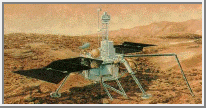











|

NASA Mars Lander
Courtesy of NASA's National Space Science Data Center
The Mars Surveyor '98 Lander is the companion spacecraft to the Mars Surveyor '98 Orbiter. The two spacecraft will be launched separately, but comprise a single mission to study the Martian weather, climate, and water and carbon dioxide budget. The data will help scientists to understand the reservoirs, behavior, and atmospheric role of volatiles and to search for evidence of long-term and episodic climate changes. This spacecraft will be launched in January 1999.
The Lander has as its primary science objectives to: 1) record local meteorological conditions near the martian south pole; 2) analyze samples of the polar deposits for volatiles, particularly water and carbon dioxide; 3) dig trenches and image the interior; and, 4) image the regional and immediate landing site surroundings. These goals will be accomplished using a number of scientific instruments, including a Mars Volatiles and Climate Surveyor (MVACS) instrument package, which is comprised of a robotic arm and attached camera, mast-mounted surface stereo imager and meteorology package, and a gas analyzer. In addition, a Descent Imager will capture regional views from parachute deployment at about 8 kilometers altitude down to the landing. The Russian Space Agency will also provide a laser ranger (LIDAR) package for the lander, which will be used to measure dust and haze in the Martian atmosphere.
The lander consists of a base with three landing legs and an exposed upper deck to hold the instruments. Two solar power arrays extend from the deck parallel to the ground on opposite sides. The imaging and meteorology masts extend upward from the deck. A two-meter long robotic arm is attached to one side of the deck, and a small parabolic dish antenna is on the opposite side. A thermally regulated payload electronics enclosure houses the temperature sensitive components.
After an 11-month cruise, the lander will make a direct entry into Mars' atmosphere in December, 1999. After using an active descent propulsion system and deploying a parachute at approximately 8 kilometers altitude it will soft-land at about 71 S latitude, 210 W longitude. This spot represents the most northerly extent of the south polar layered deposits. These deposits appear to be made of alternating layers of clean and dust-laden ice, and may represent a long-term record of the climate, as well as an important volatile reservoir. The lander will touch down during the late southern spring season and begin its primary mission, which is scheduled to last until 28 February 2000. The secondary mission will go to 31 May 2000. There are also plans for a later spring mission from 01 July 2001 to 30 September 2001.
The Mars Surveyor '98 Lander is part of NASA's 10-year Mars Surveyor Program, which will feature launches every 26 months when Earth and Mars are favorably aligned.
Views of the Solar System Copyright © 1997-2000 by Calvin J. Hamilton. All rights reserved. Privacy Statement.